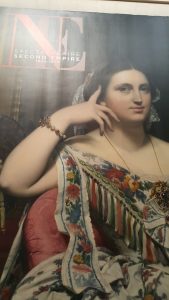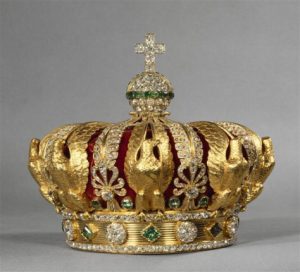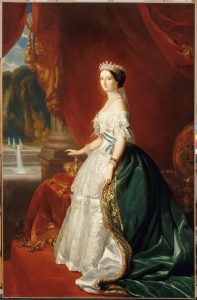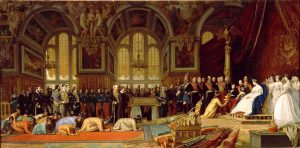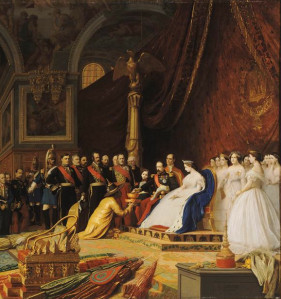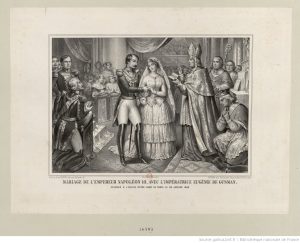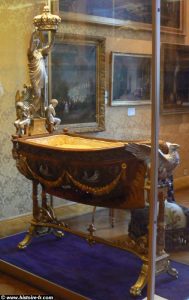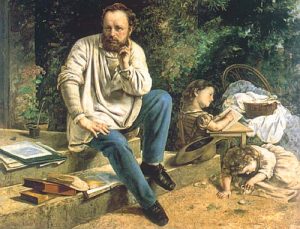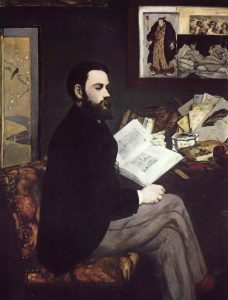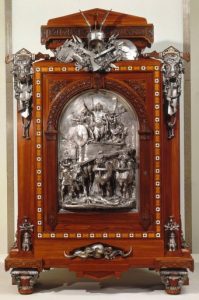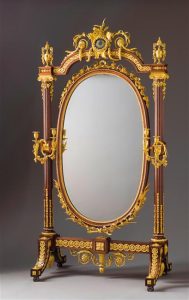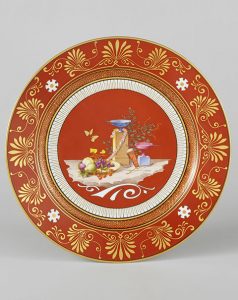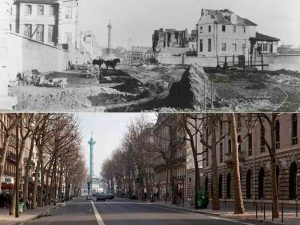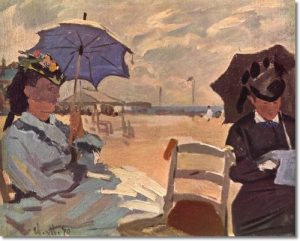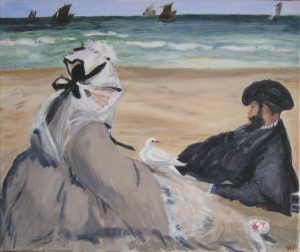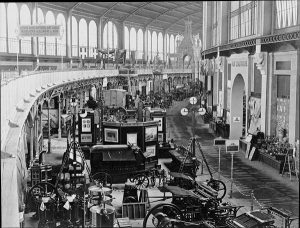- On 2016-10-19
- In blog
- Tags
Spectaculaire Second empire in Orsay
In this mid October , the little art seeker has seen the gorgeous exhibition “Spectaculaire Second Empire”in the musee d’Orsay and really loved it!
Spectaculaire second Empire :Orsay:September 27 2016-January 15 2017
Why? Well,every French people has in mind the terrible war with Prussia in 1870 that will be for years associated with the controversial figure of the emperor Napoleon III.
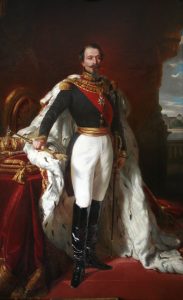 After Franz Xaver Winterhalter: Napoleon III,Emperor of the French,pre-1861.
After Franz Xaver Winterhalter: Napoleon III,Emperor of the French,pre-1861.
After this war , France will be a humiliated country and the second Empire will end in a gloomy way.
But the second Empire (1852-1870)is also synonymous of vitality and thanks to a stable imperial regime ,France will have a period of incredible prosperity, due to an extreme ecomic vitality and a desire for the rising bourgeoisie to enjoy this time of prosperity in endless celebrations.
In December 1848, Louis Napoleon Bonaparte is elected President de la République and seeks to rally the ruling elite but also to fascinate the people.To achieve his plan , he manages to organize many celebrations and wants to invite up to 2000 people!!!
After the coup d’état in December 2 1851, the feast and the celebration will develop more and more thanks to a civil list of 25 millions francs a year.
The Napoleonian system needs the popular support and the portraits of the Emperor and his wife the Empress Eugenia will represent them as the protectors of the French Nation.
In January 1853, Napoleon III marries a young Spanish countess ,Eugenie de Montijo.
She’s 27 ,and he’s 45 when they reach the cathedral Notre-Dame where their wedding is going to be celebrate.
The exhibition shows the baeutiful crown worn by Eugenia for the occasion.
Crown of the Empress Eugenia by Alexandre Gabriel Lemonnier.1855
Eugenia,empress of the French by Franz Xaver Winterhalter .1855
Eugenia and the Emperor will be together very much concerned by the Arts.The Emperor will be interested in sculptures ,paintings and even decorative Arts.
Many portraits will be realized during their reign.Some will reveal the decorum of the receptions given by Napoleon .
One huge painting in the exhibition embodies the fast of the Empire and is skilfully represented by the painter Jean Léon Gérome .It depicts the reception of the Siamese ambassadors in Fontainebleau in July 1861.
Réception des ambassadeurs du Siam par l’empereur Napoléon III au palais de Fontainebleau
Par Jean Léon Gérome
Other representations are more unusual and reveal the Emperor’s taste for “the cult of the personality”.He had no social network at the time but had already understood the power delivered by the images and asked the painter Bouguereau to represent him as a kind of hero visiting the victims of the flood in Tarascon(south of France).
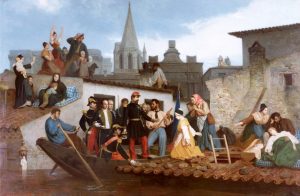 L’empereur visitant les inondés de Tarascon.William Bouguereau .Juin 1856
L’empereur visitant les inondés de Tarascon.William Bouguereau .Juin 1856
In the second room of the exhibition under the title”Lavish dynastic events”we discover how the great occasions were important places to display the imperial power.
The marriage of Napoleon and Eugenia was extremely ostentatious in order to reassert the prestige of a dynasty in search of legitimacy.
The Notre Dame cathedral was lavishly decorated by the great architect Viollet le Duc and the cradle realized for the Prince imperial offered by the City of Paris shows the great talent of the French craftsmen at the time.
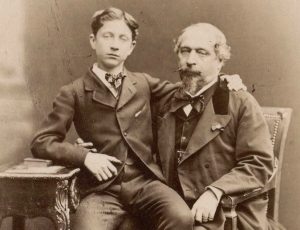 This is beautiful portrait of the Emperor and his son Eugene who died at the age of 20 ,killed by the Zulus in South Africa.The emperor had died a long time ago but the Empress Eugenia who had a unique son will be dressed in black until the end of her life in remembrance of her beloved son.
This is beautiful portrait of the Emperor and his son Eugene who died at the age of 20 ,killed by the Zulus in South Africa.The emperor had died a long time ago but the Empress Eugenia who had a unique son will be dressed in black until the end of her life in remembrance of her beloved son.
Modern or academic, the portrait will know a great success under the second Empire.As demands increase the development of photography will allow everyone to see their own image.
The great bourgeoises love to be represented in lavish interiors .In the portraits of Ingres each detail in the costume ,the discreet jewels , the academic postures,deliver the dignified image that the women should occupy in the society.The woman is the spouse of a rich banker Paul Sigisbert Moitessier and embodies the insurance of the nouvelle bourgeoisie settled in luxurious salons .
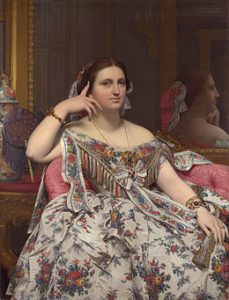 Madame Moitessier.Jean Auguste Dominique Ingres.1856
Madame Moitessier.Jean Auguste Dominique Ingres.1856
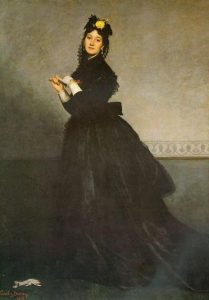 Carolus Duran :La dame au gant .1869
Carolus Duran :La dame au gant .1869
The portrait will also become a manifesto for modernity and will be considered as the symbol of the modern painting for many young painters as Manet and Courbet.
Two interesting paintings represent for the first one:Proudhon who is painted by Courbet( who supports his political ideas for a enlightened socialism) surrounded by his books and children ,dressed as a simple worker and facing the audience .
Pierre Joseph Proudon et ses enfants en 1853.Gustave Courbet
Emile Zola for the second one in a beautiful portrait by Manet.The two men were friends and Zola had several times defended the painter of Olympia ,the new master of modernity,whose place was for him inside the Louvre.
Edouard Manet:Emile Zola.1868
The era is with eclectic tastes.In 1867 when Garnier inaugurates the Opera in Paris,the empress a little bit amazed asks him”but which style is it?It’s not antique, it’s not Middle ages it’s not Renaissance!”The answer was : but Madame “it”s second empire”.
More than ever the eclectism is king under Napoleon III.The interiors in all the mansion houses are covered with extravagant ornementation,colors and materials with a great range of diversity!
The furniture belongs to all ages ,is inspired by the East and is also cosy ,solid and innovative.In its profusion and sophistication ,the second Empire decor reveals all the ecomic prosperity, the new ideas and the richness that characterize the era.
Charles Guillaume Diehl,Jean Brandely,Emmanuel Fremiet
Médaillier,triomphe de Mérovée .1867
Jules Dieterle,manufacture de Sèvres
Napoleon will undertake great transformations of Paris making of it a modern city with the help pf the Baron Haussmann.
Haussmann will make of the medieval city a modern one with great perspectives,large boulevards.His mission:to get the capital rid of tuberculosis and cholera by distroying hundreds of unhealthy buildings.
The vision shared by Haussmann and Napoleon will give a new face to Paris,the one of the 20th century.
The second Empire was also an era of new leisure :some liked to go boating on the Seine on the outskirts of Paris, while the bourgeoisie discovered through the railroad new trips to the race courses and to seaside .Boudin , Manet and Monet were the painters of the modern life and illustrated the new taste for the grand air and the promenade on the beach amid the ruling classes.
Claude Monet:The beach at Trouville.1870
Sur la plage.Edouard Manet
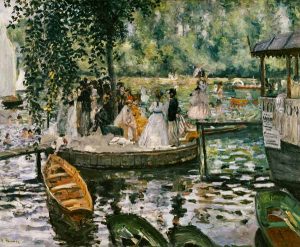 la grenouillère .Pierre Auguste Renoir.1869
la grenouillère .Pierre Auguste Renoir.1869
The universal exhibitions that took place in 1855 and 1867 were the showcase of the French know how and reflected the prosperity of the empire.
The emperor and the French industrialists supported them with enthusiasm.
In 1867,the exhibition attracted 11 million visitors between April and October including a great number of prestigious guests.It showed to the world the technical prowess ,the potential of French industry and the skill of designers who drew inspiration from mythology,national history, Chinoiserie or classical Antiquity.
The end of the exhibition is devoted to one of the most important artistic event of the capital that still dominated the art world under the second Empire: the salon.
Every year thousands of artists submitted their work to the critics of the public .The salon welcomed paintings from all kinds:Delacroix, students of Ingres,canvases by Courbet and Orientalist views.There were so many works accepted that some had to be hung very high on the walls.
Many artists were rejected and so were many of the impressionists who created a parallel exhibition in 1853 known as the Salon des Refusés:Manet ‘s déjeuner sur l’herbe”caused a scandal there.
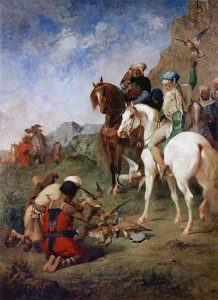 Eugène Fromentin :chasse au faucon en Algérie,la curée.1863
Eugène Fromentin :chasse au faucon en Algérie,la curée.1863
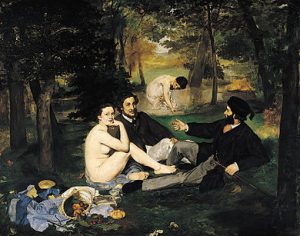 Edouard Manet.Le déjeuner sur l’herbe.1863
Edouard Manet.Le déjeuner sur l’herbe.1863
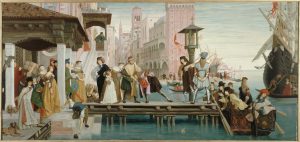
James Jacques Joseph Tissot (1836-1902). “Le départ de l’Enfant Prodigue”, 1863. Huile sur toile. Musée des Beaux-Arts de la Ville de Paris, Petit Palais.
So dear friends if you have a little time ,when you come to visit our beautiful city don’t hesitate and visit this thrilling exhibition in the musée d’Orsay.
The little art seeker recommends it !!!


